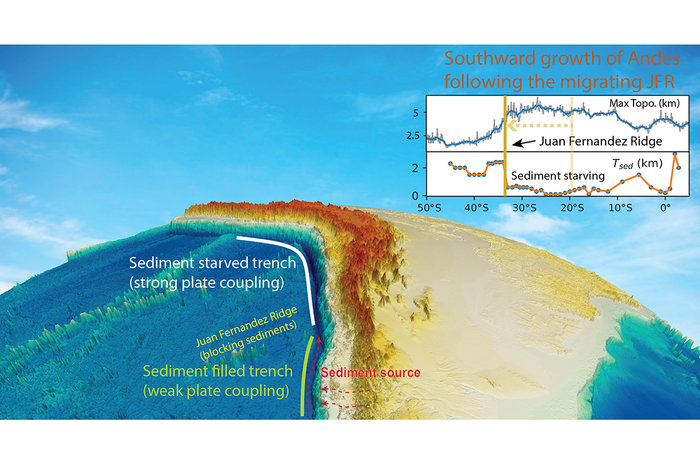The Andes Mountains are much taller than plate tectonic theories predict they should be, a fact that has puzzled geologists for decades. Mountain-building models tend to focus on the deep-seated compressional forces that occur when tectonic plates collide and send rocks skyward. A new study demonstrates how modern top-down models that account for climate-related factors combined with traditional bottom-up tectonic models can help uncover the perplexing history of the Andes Mountains.
The study, led by former University of Illinois Urbana-Champaign graduate student Jiashun Hu, Illinois geology professor Lijun Liu and California Institute of Technology professor Michael Gurnis, is published in the journal Nature Communications.
“The Andes are unique for their tectonic setting,” Liu said. “The central portion of the range is abnormally tall for one formed by the relatively low compressional stress and weak plate interface coupling we think occurs when thin, dense oceanic crust subducts—or slides under—thick continental crust.”
Geochemical and chronological data indicate the most recent Andean Mountain building phase began 40 million years ago, and the most significant crustal shortening—the process of mountain formation—started at the central-to-northern part of the present-day Andes and gradually expanded toward the south.
There is geologic evidence preserved along the Andean coast indicating that the southward expansion of Andean Mountain growth continues today, Liu said, but what is causing this migration and significant crustal deformation is still unclear.
Numerous studies show that higher erosion rates in the southern Andes, due to a warmer and wetter climate than in the north, correspond chronologically with evidence of an increased influx of sediment into the Andean Trench. The researchers said this sediment, which settled along the bottom of the trench along the subducting edge Nazca plate, may have acted as a lubricant atop the subducting plate by reducing compressional forces and resulting in lower mountains.
Liu’s team has taken this climatic-tectonic relationship a step further by uncovering the effect of a curious east-west trending feature known as the Juan Fernandez Ridge—a submerged volcanic hotspot chain that still exists today.
“Today, where the Juan Fernandez Ridge intersects the coast of Chile, it acts as a barrier to the northward-migrating sediments,” said Hu, the lead author of the study. “We hypothesize that this ridge has existed for millions of years, slowly migrating southward with the subducting Nazca Plate, starving the northern Andean Trench of sediments that helped increase the plate coupling and mountain building behind the migrating ridge.”
The team’s new model accounts for the impact of the Juan Fernandez Ridge on sediment transport through time.
“When we use our model to reverse time and reconstruct the subduction history of the Nazca Plate in 3-D space, the effects of including the Juan Fernandez Ridge correspond remarkably well with geologic features we see in the Andes today,” Hu said.
The model has yet to be tested with the extensive range of hypotheses that exist for the formation of the Andes Mountains—some of which include incredibly complex plate subduction geometries, the study reports.
“This study is a critical step forward to have the ability to quantitatively link climate and tectonics—something not well represented in the past studies,” Liu said.
More information:
Jiashun Hu et al, Southward expanding plate coupling due to variation in sediment subduction as a cause of Andean growth, Nature Communications (2021). DOI: 10.1038/s41467-021-27518-8
Provided by
University of Illinois at Urbana-Champaign
Citation:
Study combines climatic, tectonic models to explain Andean conundrum (2021, December 14)



